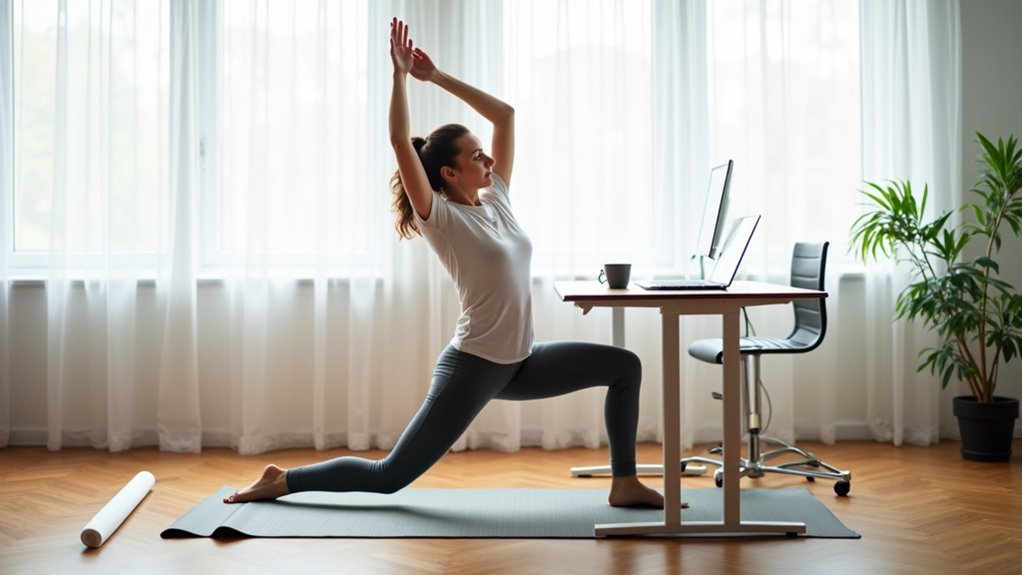You’re probably familiar with the aches and stiffness that come from sitting all day. Those endless hours at your desk aren’t just uncomfortable—they’re slowly wearing down your body’s natural mobility and strength. But what if you could reclaim your physical well-being in just 15 minutes daily? Yoga offers a targeted, transformative solution for desk workers, addressing the specific challenges of sedentary life. The right sequences can reverse posture damage, boost energy, and restore your body’s essential connection between movement and stillness. Curious how?
Key Takeaways
- Begin with a 5-minute morning energizing sequence focusing on spine mobility, wrist flexibility, and gentle neck stretches to counteract sedentary work postures.
- Integrate midday 10-minute stress-relief breathing techniques like 4-7-8 method and seated mobility exercises to reset mental clarity and physical tension.
- Practice targeted stretches targeting key problem areas for desk workers: hamstrings, hip flexors, lower back, and shoulders to prevent musculoskeletal disorders.
- Create a consistent evening 15-minute routine incorporating strength-building poses like low squats, downward dog, and cat-cow movements to enhance overall body resilience.
- Implement micro-breaks throughout the workday with quick mobility exercises, prioritizing intentional movement to combat the health risks of prolonged sitting.
Why Your Desk Job Needs Yoga

While desk jobs have become increasingly common in our modern workforce, the physical toll they take on your body can be significant. You’ll spend much time sitting, which increases your risk of musculoskeletal disorders and chronic pain. Studies reveal that 60-80% of office workers experience back pain, often from poor posture and prolonged sedentary behavior.
Yoga offers a holistic solution to counteract these workplace challenges. By integrating simple stretches and mindful movements—even placing your right foot strategically during poses—you can dramatically improve flexibility, reduce tension, and enhance cognitive function. Regular practice doesn’t just address physical symptoms; it provides a thorough approach to workplace wellness, potentially mitigating serious health risks associated with sedentary lifestyles and boosting your overall productivity and well-being.
Essential Stretches for Sedentary Professionals

Given the rising prevalence of desk jobs and their associated physical challenges, professionals need targeted strategies to combat sedentary-related health risks. Your desk ergonomics and posture alignment are essential in mitigating potential long-term physical strain. Incorporate simple yet effective stretches targeting wrists, forearms, spine, and lower body to counteract hours of sitting.
Set stretch reminders throughout your workday to engage in quick mobility exercises. Focus on extending arms, pulling fingers back, performing cat and cow movements, and practicing lunges. These targeted stretches won’t just alleviate immediate tension; they’ll enhance your overall physical resilience.
Wrist and Forearm Mobility Techniques

The repetitive nature of desk work can wreak havoc on your wrists and forearms, making targeted mobility techniques essential for maintaining physical health. You’ll want to incorporate wrist flexibility exercises that combat the strain of constant typing and mouse usage. Start by extending your arm and creating gentle wrist circles in both directions, which immediately improves blood flow and reduces stiffness.
Utilize forearm strengtheners like pulling back on your fingers with the opposite hand, stretching the top of your wrist and releasing built-up tension. Remember to perform these movements every hour to prevent potential injuries like carpal tunnel syndrome. After each set of stretches, shake out your wrists to promote muscle relaxation and enhance overall mobility, ensuring your arms remain supple and pain-free throughout your workday.
Spinal Health for Office Workers

Because sedentary work can silently compromise your spinal health, desk workers must prioritize targeted mobility exercises that counteract prolonged sitting’s detrimental effects. Spinal alignment importance cannot be overstated—your daily posture directly impacts long-term wellness.
Mobility exercise benefits emerge through consistent, intentional stretching. By integrating practices like cat-cow movements and downward facing dog, you’ll enhance flexibility and reduce muscular tension. These strategic stretches don’t just alleviate immediate discomfort; they promote blood circulation and prevent chronic back issues.
Your routine should include short, frequent breaks dedicated to spinal mobilization. Focus on gentle, deliberate movements that restore natural curvature and release accumulated stress. With mindful practice, you’ll transform sedentary challenges into opportunities for increased productivity and holistic physical well-being.
Hip Opening Movements for Desk Employees

Five critical hip opening movements can transform your desk-bound workday from a sedentary struggle to a dynamic wellness experience. By integrating targeted hip flexibility exercises, you’ll combat the negative effects of prolonged sitting and restore mobility.
- Practice low squats to release hip flexor tension
- Incorporate seated hip stretches during work breaks
- Perform standing lunge variations to enhance range of motion
- Use pigeon pose for deep hip opening and tension relief
- Implement downward facing dog to stretch hamstrings and improve overall hip mobility
These strategic movements counteract stiffness, improve posture, and support your body’s natural alignment. Just a few minutes daily can dramatically reduce discomfort, increase flexibility, and create a more balanced physical experience for desk workers seeking holistic wellness through intentional movement.
Breathing Techniques to Reduce Workplace Stress
While hip-opening movements provide physical relief for desk workers, breathing techniques offer a powerful mental and physiological counterpart to workplace stress management. By integrating simple breathing exercises into your daily routine, you’ll discover immediate stress relief and enhanced workplace mindfulness. The 4-7-8 technique can quickly calm your nervous system, reducing anxiety and improving emotional regulation. Just a few minutes of diaphragmatic breathing can lower your heart rate and decrease stress hormones, helping you regain focus and productivity. Intentional breath awareness allows you to create micro-breaks throughout your workday, transforming moments of overwhelm into opportunities for mental reset. These mindful practices aren’t just techniques—they’re essential tools for maintaining professional composure and personal well-being in demanding work environments.
Quick Yoga Sequences You Can Do at Your Desk
Anyone working at a desk knows the physical toll of prolonged sitting, making targeted yoga sequences a critical self-care strategy. Desk yoga offers quick stretches that can transform your office wellness routine, helping you combat stiffness and tension throughout the workday.
- Wrist and forearm circles relieve typing strain
- Seated cat and cow movements mobilize your spine
- Standing forward bends stretch hamstrings and lower back
- Lunges open hips and chest, improving flexibility
- Deep breathing exercises reset mental clarity
These targeted movements take just minutes but provide significant physical and mental benefits. By integrating these office-friendly yoga sequences, you’ll counteract sedentary work habits, reduce muscular tension, and boost overall well-being. The key is consistency and mindful movement, turning your workspace into a mini wellness sanctuary that supports your body’s need for movement and restoration.
Preventing Repetitive Strain Injuries
Because repetitive strain injuries (RSIs) represent a significant occupational health challenge, desk workers must proactively protect their musculoskeletal system through strategic prevention techniques. Your ergonomic setup and posture awareness are critical in mitigating potential injuries. By implementing regular stretching reminders and incorporating targeted mobility exercises, you’ll reduce strain on vulnerable muscle groups.
| Prevention Strategy | Frequency | Impact |
|---|---|---|
| Desk Stretches | Hourly | High |
| Ergonomic Adjustments | Daily | Moderate |
| Micro-Movement Breaks | Every 30 mins | High |
| Wrist Mobility Exercises | Twice Daily | Moderate |
Understanding the interconnection between prolonged sitting, repetitive motions, and potential injury allows you to develop a holistic approach to workplace wellness. By prioritizing your body’s needs and integrating simple, consistent preventative practices, you’ll safeguard your long-term musculoskeletal health effectively.
Mindful Movement for Better Productivity
As desk workers navigate increasingly demanding professional landscapes, mindful movement emerges as a strategic approach to enhancing workplace productivity and personal well-being. By integrating short, targeted yoga routines, you’ll transform your workday into a more dynamic and energized experience. These mindful productivity techniques offer multiple benefits:
- Reduce physical tension through intentional stretching
- Improve blood circulation with 15-minute movement breaks
- Lower stress levels through breath-centered exercises
- Enhance mental clarity and creative problem-solving
- Prevent musculoskeletal disorders through spinal mobility
Workplace wellness strategies aren’t just about physical health—they’re about creating a holistic approach to professional performance. When you prioritize mindful movement, you’re investing in your body’s resilience and your cognitive potential. Each intentional stretch and breath becomes a powerful tool for maintaining focus, managing workplace stress, and sustaining high-performance levels throughout demanding workdays.
Creating a Sustainable Wellness Routine
When desk workers commit to a sustainable wellness routine, they transform sedentary work patterns into opportunities for physical and mental rejuvenation. Developing mindful habits means creating a daily commitment that adapts to your unique schedule and energy levels. The key is routine flexibility, allowing you to integrate short yoga sessions that counteract prolonged sitting’s negative impacts.
| Time of Day | Duration | Focus Area |
|---|---|---|
| Morning | 15 mins | Energizing Stretches |
| Midday | 10 mins | Stress Relief |
| Evening | 15 mins | Mobility Reset |
Your wellness journey isn’t about perfection but consistent, intentional movement. By setting a specific time each day and choosing adaptable practices, you’ll gradually build strength, improve posture, and enhance overall well-being. Remember, small, regular investments in your physical health can yield significant long-term benefits, making every minute of practice count.
Frequently Asked Questions
Is 15 Minutes of Yoga a Day Enough?
You’ll find 15 minutes of daily yoga can provide substantial benefits for workplace wellness, offering meaningful improvements in flexibility, stress reduction, and overall health when practiced consistently and mindfully.
How to Do Yoga in the Office?
80% of office workers experience musculoskeletal pain. You’ll boost productivity by practicing office stretches and mindfulness techniques. Find a quiet space, focus on breath, and perform gentle yoga poses that release tension, helping you stay centered and energized throughout your workday.
Will 10 Minutes of Yoga a Day Make a Difference?
You’ll definitely see benefits from 10 minutes of daily yoga. It’s a powerful stress relief tool that provides quick relaxation techniques, enhancing your mental and physical well-being through consistent practice, even in short, manageable sessions.
Can I Do Yoga at Work?
Yes, you can definitely do yoga at work! It’ll help you manage stress, improve workplace mindfulness, and relieve physical tension through quick desk stretches. You’ll boost your productivity and well-being with just a few simple yoga benefits each day.
Conclusion
Don’t let your desk job dictate your health. Research suggests that consistent yoga practice can dramatically reverse the physical toll of sedentary work. By dedicating just 15 minutes daily to intentional movement, you’ll not only combat muscular stiffness and mental fatigue but also rewire your body’s stress response. Your future self will thank you for investing in holistic wellness today—one stretch at a time.



